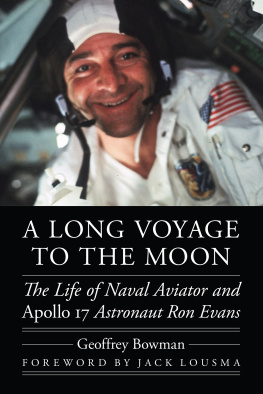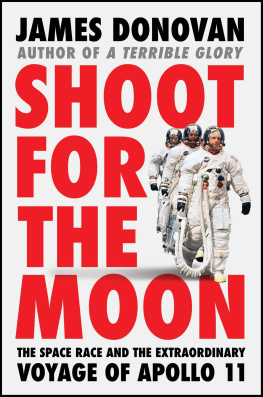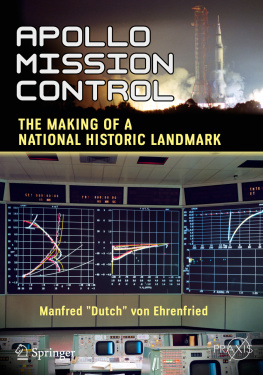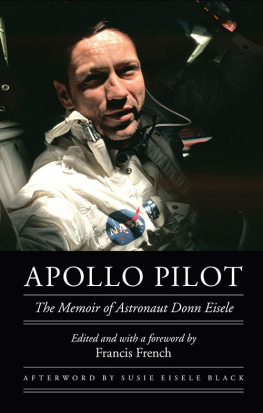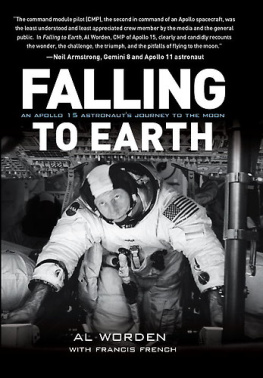Stafford Thomas - We have capture: Tom Stafford and the space race
Here you can read online Stafford Thomas - We have capture: Tom Stafford and the space race full text of the book (entire story) in english for free. Download pdf and epub, get meaning, cover and reviews about this ebook. City: UNITED STATES;USA;Washington;D.C;United States, year: 2002;2014, publisher: Smithsonian Institution Press, genre: Non-fiction. Description of the work, (preface) as well as reviews are available. Best literature library LitArk.com created for fans of good reading and offers a wide selection of genres:
Romance novel
Science fiction
Adventure
Detective
Science
History
Home and family
Prose
Art
Politics
Computer
Non-fiction
Religion
Business
Children
Humor
Choose a favorite category and find really read worthwhile books. Enjoy immersion in the world of imagination, feel the emotions of the characters or learn something new for yourself, make an fascinating discovery.

- Book:We have capture: Tom Stafford and the space race
- Author:
- Publisher:Smithsonian Institution Press
- Genre:
- Year:2002;2014
- City:UNITED STATES;USA;Washington;D.C;United States
- Rating:3 / 5
- Favourites:Add to favourites
- Your mark:
- 60
- 1
- 2
- 3
- 4
- 5
We have capture: Tom Stafford and the space race: summary, description and annotation
We offer to read an annotation, description, summary or preface (depends on what the author of the book "We have capture: Tom Stafford and the space race" wrote himself). If you haven't found the necessary information about the book — write in the comments, we will try to find it.
We have capture: Tom Stafford and the space race — read online for free the complete book (whole text) full work
Below is the text of the book, divided by pages. System saving the place of the last page read, allows you to conveniently read the book "We have capture: Tom Stafford and the space race" online for free, without having to search again every time where you left off. Put a bookmark, and you can go to the page where you finished reading at any time.
Font size:
Interval:
Bookmark:
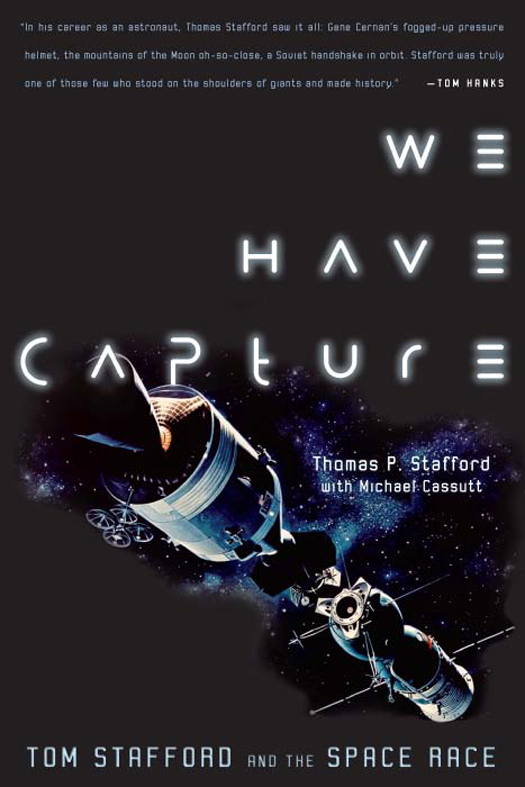
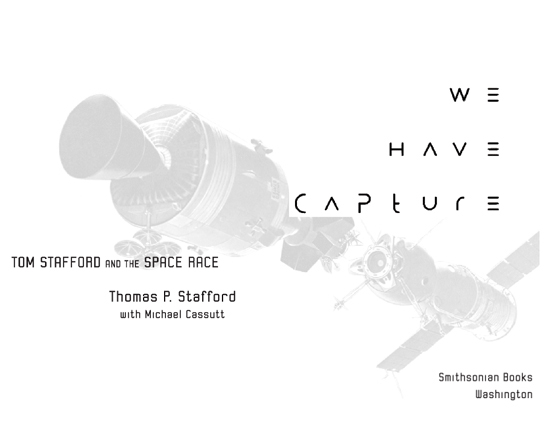
This book is based in large part on research
and interviews conducted by James E. Alexander, Ph.D.
2002 by Thomas P. Stafford and St. Croix Productions, Inc.
All rights reserved
Copy editor: Craig A. Triplett
Designer: Brian Barth
Library of Congress Cataloging-in-Publication Data
Stafford, Thomas P.
We have capture : Tom Stafford and the space race /
Thomas P. Stafford with Michael Cassutt.
p. cm.
ISBN 1-58834-070-8 (alk. paper)
eBook ISBN 978-1-58834-435-9
1. Stafford, Thomas P. 2. AstronautsUnited StatesBiography.
3. AstronauticsUnited StatesHistory. 4. Space race. I. Title.
TL789.85.S73 A3 2002
302.34081022dc21
2002021019
British Library Cataloguing-in-Publication Data available
An electronic reissue (ISBN 9781588344359) of the original cloth edition
For permission to reproduce illustrations appearing in this book, please correspond directly with the owners of the works, as listed in the individual captions (uncredited photos belong to Thomas P. Stafford). Smithsonian Books does not retain reproduction rights for these illustrations individually, or maintain a file of addresses for photo sources.
This book may be purchased for education, business, or sales promotional use. For information please write: Special Markets Department, Smithsonian Books, P.O. Box 37012, MRC 593, Washington, DC 20013
www.smithsonianbooks.com
v3.1
To my family, to my co-workers, and to my colleagues in Russia
T he authors wish to acknowledge the assistance of Maj. Gen. Aleksei Leonov for his insights into the Soviet and Russian side of the space race. Dr. Arnauld Nicogossian, Maj. Gen. Joe Henry Engle, and Anatole Forostenko also shared their valuable perspectives.
Photos and other materials were kindly provided by Chuck Biggs; Bill Moore at Oklahoma Educational Television; Kathy Strawn (Media Services) and Glen Swanson (History Office) at the NASA Johnson Space Center; and Greg Linebaugh and Stewart Howard at the Oklahoma Air and Space Museum in Oklahoma City. Dennis McSweeney, Holly Stevens, and Mark Thiessen of the Stafford-Utkin Task Force performed support services above and beyond the call of duty, as did Patricia McCown and Karen Stover of FlexForce.
We offer a special thank you to our wives, Linda Stafford and Cindy Cassutt.
A t 10:00 A.M . Houston time we were in sunlight when I saw the bright dot that was Soyuz 19. Seventeen minutes later, as we flew north of Australia, it was time for the terminal phase initiation maneuver. Closer and closer. By the time we approached the coast of Chile, Apollo was essentially station-keeping with Soyuz. I tweaked the reaction-control thrusters and continued to look outside, where I could now see Soyuz 19 clearly.
My crew mates, Vance Brand and Deke Slayton, and I were approaching the high point of a two-year journey, in which we had become the first American astronauts to work and train at the heart of the Soviet space program. A few short years ago, I had been a fighter pilot patrolling the Iron Curtain. My Soviet counterpart, Soyuz commander Aleksei Leonov, had done the same on his side. In working with the cosmonauts, in struggling to learn their language, in traveling in their world, I had stopped seeing them as faceless enemies, but now recognized them as complicated human beings trying to make the best of a terrible and complicated political system. And here we were, getting ready to link our two spacecraft 132 miles above the surface of the earth.
Ive got two messages for you, Dick Truly, the capcom in Houston, advised us. Moscow is go for docking, Houston is go for docking. Its up to you guyshave fun. It was 10:46 A.M . CDT, the morning of July 17, 1975.
Half a mile, I radioed in Russian to Aleksei.
Roger, eight hundred meters, he said in English. He and his flight engineer, Valery Kubasov, had, as planned, closed the hatch between the orbit and descent modules, put on their pressure suits, and were in the couches. We had closed the hatch to our docking module, too. On my command, in Russian, Aleksei made a final sixty-degree roll to get Soyuz in the right orientation.
We edged closer and closer. At one point Aleksei said, Tom, please dont forget about your engine. He was reminding me to inhibit the forward-firing thrusters. Already done. I called out the ranges in Russian. Five meters, three meters, one meter, contact. Capture, I reported.
We have capture, Aleksei repeated, in Russian. It was 11:10, and we had linked up over the Atlantic Ocean just east of the coast of Portugal.
I ts a long way to Russia and earth orbit from Weatherford, Oklahoma, which is where I was born on September 17, 1930, the only child of Thomas Sabert Stafford, a dentist, and the former Mary Ellen Patten, a teacher. I was a small baby, weighing only four and a half pounds, and was fortunate to survive infancy. Weatherford, which lies seventy miles due west of Oklahoma City, had a population of twenty-four hundred supported by cotton, wheat farming, and cattle, and by the presence of the Southwestern State Teachers College, with its eight hundred students.
The first transcontinental airline route happened to run right across Weatherford, following U.S. Route 66, which was also the towns main street. Every afternoon a silver DC-3 would glide across the sky on its way to Amarillo, then Los Angeles, having flown from New York, Chicago, St. Louis, and Oklahoma City. Even as a small boy, I would stand there and watch, and think, I want to do that.
Weatherford was small enough that you knew everyone but not so big that you couldnt get around quickly and easily. We lived in a five-room, one-story house at 215 Washita Street, two blocks north of Main and two blocks south of the junior and senior high schools. We never needed an automobile.
We did have books, however. My mother, who gave up her teaching job to raise me, read to me from the time I was a baby, everything from Big Little Books, to the Bible, from fairy tales to funny pages in the newspapers. (I became a big fan of Buck Rogers.) It helped make me a lifelong reader.
There were drawbacks to life on the prairie, however. Summer nights were so hot that the family would take cots out back and sleep under the stars. (This was long before air-conditioned homes.) My father knew some of the constellations, and he would point them out to me. I would look at the Moon, which seemed so close, and wonder whether we would ever touch its surface. I thought that perhaps some day people might go there. But I never dreamed it would be me.
The middle 1930s was also the time of the dust bowl, when the hot wind would start blowing from the south, and the sky would turn red, then gray. Then wed get hit by a black cloud so thick that the family would have to shove dampened towels against the doors and around the windows to keep out the flying dirt. I was too young to know about farmers losing their land and having to go on the road, but I knew times were tough; we never had much money because many people would postpone dental work for as long as possible, and when they finally had to have it, they would often pay in trade, not cash.
Nevertheless, my childhood was a happy one. I had the run of the town with buddies like Richard McPhetridge, who lived across the street. And though my parents (especially my mother) were tough when they needed to be, sometimes they let me push the envelope. When I was four years old, for example, we visited a farm near the town of May, which had a windmill that was eighty-five feet tall, one of the tallest in the world. I took one look at that thing and headed right for it, my little legs churning as fast as they could. I was up that ladder and all the way to the platform at the topeight stories upbefore my parents noticed I was gone. I had never been up that high before. I can still remember seeing for miles in every direction, all the fences, roads, farm houses, the low hills, and some of the few trees of western Oklahoma. Typically, there was a good stiff breeze blowing, making the vane at the top of the windmill creak as it swung back and forth. I had to keep ducking out of its way, but I didnt care: As far as I was concerned, I was on top of the world. Spotting me up there, my parents pleaded with me to be careful. My father was about to climb up and get me, but I yelled that I would come down myself. Which I did. I learned several things that day. First, that I liked the feeling of being way up high. Second, that rules could sometimes be broken. And third, that climbing down can be a lot harder than going up.
Font size:
Interval:
Bookmark:
Similar books «We have capture: Tom Stafford and the space race»
Look at similar books to We have capture: Tom Stafford and the space race. We have selected literature similar in name and meaning in the hope of providing readers with more options to find new, interesting, not yet read works.
Discussion, reviews of the book We have capture: Tom Stafford and the space race and just readers' own opinions. Leave your comments, write what you think about the work, its meaning or the main characters. Specify what exactly you liked and what you didn't like, and why you think so.


